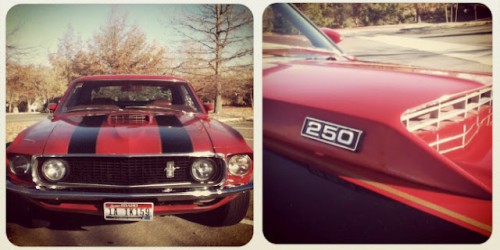Hot Pipes and Pin Stripes
I purchased my first car at the age of 16 on a cold day in January. She was a 1969 Ford Mustang Coupe, which I managed to pick up in an estate auction for just under $2,000, and she is still my daily driver to this very day. Before the purchase, the process of searching for this my first car lasted nearly a year, during which time my father taught me the ins and outs of shopping used.

Exhaust makes all the difference – A fast-sounding and great-looking Mustang with an original straight six.
I checked out many makes and models of cars, test-driving each to get a feel, and it was not long before I realized the car would have to be a classic or nothing. Though I was not sure at the time what I would end up with, there was one requirement that I had to adhere to by order of my parents: no V8s. Insurance costs, safety, and the fact that my parents actually knew what I was capable of were all reasons for this decision on their end.
Fully resolved to the fact that my parents could not be swayed on this issue, I knew I would have to make due with what ever I could get my hands on. I ended up with a 250ci straight six to provide the pulse for my Mustang, with hopes of possibly one day swapping it out for a 302 once I left my parents supervision. However, until then, I became very interested in finding ways to enhance my six and try and make it less obvious that I was packing very little heat under the hood.
The number one modification I made that satisfied this desire was the installation of my current exhaust system. I say current, because after all these years I have kept the six, because with the exhaust and other modifications most people believe the car to be an 8 in both sound and performance.
This is not to say that I try to fool people. The fact that I have been able to create such great performance from a six block is a thing of pride for me. I keep the “250” badges that I custom made in high school polished and easily visible on the hood scoop. When I pull up to the tanks to fill, people will sometimes ask why I have not changed the badging, and are surprised when I say it is still the original six. Their response typically falls along the lines of: “well it sure doesn’t sound like a six.”
The sound—which I am very proud of—is a throaty rumble at idle, with a slightly more pitted pitch on acceleration. It is when the car is cruising around 3,500 that the pitch is higher and less “eight-like,” though still not the sound of your typical six. I was able to achieve this primarily through the addition of the split headers purchased from a company call 6=8 Clifford Performance. The headers initially came with a thick gasket and a port divider, because the third and fourth exhaust ports are combined into one, and the divider provided is used partition the two for presumed “increased performance.”
After a year of burning out the several gaskets and the divider falling loose—resulting in an annoying rattle—I removed the divider and replaced the gasket with the standard manifold gasket. I have not had a problem since, and I noticed no change in sound or performance since removal. The headers lead into an X-pipe and down to a set of 40 series Flowmaster mufflers before exiting out the back through dual tipped pipes, which protrude through dual cutouts in the rear valance.
What it comes down to is that the exhaust is an important aspect of any restoration or modification. The pipes truly give a unique voice to your ride, one that can really make a powerful statement. Some people simply aim for decibels, where others just want to keep it as quiet as possible. For me, I wanted to initially mask an insecurity, and I now have a sound that is entirely my own. If you are unsure what you want, ask around. I personally am always happy to share my set up when folks come up to ask. In the end, it’s all about what makes you happy.
About the Author: Jack Payton is a car nut in the purest form. He loves to write about everything gear related, and rebuilt his first engine at 15. He works as the online publisher for the online tire retailer tires-easy.com. In his spare time he enjoys cruising, attending car shows, and collecting vinyl.








